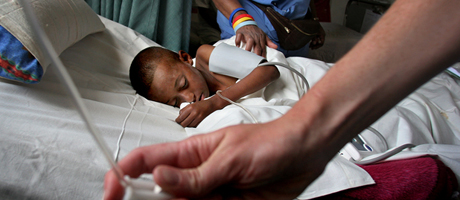Oct. 7, 2010
The federal government today announced a major push to enhance medical education in sub-Saharan Africa and boost the number of health care workers there, with the GW Medical Center serving as the coordinating hub of the initiative.
The overall $130 million, five-year program—funded through the President’s Emergency Plan for AIDS Relief (PEPFAR) and the National Institutes of Health—will build a network of partnerships between African institutions in a dozen countries and U.S. medical schools and universities.
GW received $12.5 million dollars from the government to establish a coordinating center that will evaluate the progress of these programs, help provide expertise and facilitate communication between the institutions.
The university is “honored” by the opportunity, said John F. Williams, senior vice provost and vice president for health affairs at GW. “Having a hand in training more health care workers in Africa will positively impact the lives of so many people.”
The project, called the Medical Education Partnership Initiative, will work toward PEPFAR’s goal of training and retaining 140,000 new health care workers and will, on the whole, help sub-Sarahan nations expand their abilities to provide health care.
The vast region, GW experts say, has around 15 physicians for every 100,000 people and shoulders nearly one-quarter of the global burden of disease (a calculation of mortality, injuries and illnesses). That includes having the world’s highest incidence of maternal and child mortality, and the highest prevalence of malaria and HIV/AIDS.
Much of the funding under the initiative will focus on medical education and research training related to HIV/AIDS, while other grants will cover the training of researchers and clinicians on other pressing health issues, such as maternal and child health, cardiovascular disease, cancer and mental illness.
In GW’s role as the coordinating center, the Medical Center will be evaluating the progress and impact of these programs through data collection and annual site visits.
To facilitate the sharing of data and learning experiences among institutions, the Medical Center will develop a Web-based platform and coordinate virtual and face-to-face meetings, including an annual symposium.
GW also will be working with the African Centre for Global Health and Social Transformation to provide other grantees with technical expertise and links to further resources to help augment research and teaching methods.
The GW end of the project is led by researchers Fitzhugh Mullan, the Murdock Head Professor of Medicine and Health Policy, and Seble Frehywot, an assistant research professor of health policy and global health, both from the School of Public Health and Health Services.
The endeavor is not the first foray into Africa for either the two principal doctors or the Medical Center.
Dr. Mullan and Dr. Frehywot were leading the recently completed Sub-Saharan African Medical Schools Study—funded by the Bill and Melinda Gates Foundation and housed at SPHHS—which tracked the state of medical education in that region.
And in December 2009, the Partnership for Eritrea—a collaboration between the GW Medical Center, Physicians for Peace and the Eritrean government—more than doubled the number of pediatricians in the East African nation when it graduated the first eight pediatricians from its residency program at Eritrea’s Orotta School of Medicine. The school’s first class of 31 medical students graduated that day, as well.
The partnership also launched residency training programs in surgery and obstetrics/gynecology before ending its work in the region this year, according to its website.


